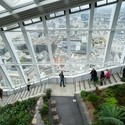Hazards in the workplace
City of London Corporation/Antoine Buchet

Disclaimer
Disclaimer: While every effort has been made to ensure the accuracy of the information contained in the Pink Book, we regret that we cannot be responsible for any errors. The Pink Book contains general information about laws applicable to your business. The information is not advice and should not be treated as such. Read our full disclaimer.
Key facts
All employers must consider the risks to staff arising from the hazards associated with aspects of the workplace. A hazard is something with the potential to cause harm.
The working environment must be suitable, at a reasonable temperature, have adequate lighting and ventilation, and include sufficient rest facilities.
Employers should reduce the risk of slips, trips and falls by cleaning spillages, keeping walkways clear and organising work more efficiently.
All electrical systems in places of work must be maintained ‘so far as is reasonably practicable’, to avoid danger to all who use the premises (including guests).
Although Health and Safety can be a complex area of legislation, there are two main sets of regulations that you need to be aware of: the Workplace (Health, Safety and Welfare) Regulations 1992 and the Management of Health and Safety at Work Regulations 1999.
The Workplace (Health, Safety and Welfare) Regulations 1992
The Workplace (Health, Safety and Welfare) Regulations 1992 cover your employees’ working environment, setting out the requirements in respect of:
- The quality of the working environment (for example reasonable temperature, lighting and ventilation).
- Suitability of the environment (for example room dimensions, space, passageways and windows).
- The facilities for your employees (for example toilets, washing and eating facilities, drinking water, changing and rest areas and rest facilities for pregnant women).
- The maintenance and cleanliness of the workplace, equipment and facilities.
The Management of Health & Safety at Work Regulations 1999
The main requirement of the Management of Health and Safety at Work Regulations 1999 is that employers must carry out risk assessments to eliminate or reduce risks. Employers with five or more employees need to record the significant findings of a risk assessment; it is not necessary to record risk assessments for trivial or insignificant risks. In addition, employers must also:
The main requirement of the Management of Health and Safety at Work Regulations 1999 is that employers must carry out risk assessments to eliminate or reduce risks. Employers with five or more employees need to record the significant findings of a risk assessment; it is not necessary to record risk assessments for trivial or insignificant risks. In addition, employers must also:
Make arrangements for implementing the health and safety measures identified as necessary by risk assessments.
Monitor and review those arrangements.
Appoint people with sufficient knowledge, skills, experience and training to help them to implement these arrangements.
Set up emergency procedures and provide information about them to employees.
Provide clear information supervision and training for employees, and ensure that suitably competent people are appointed who are capable of carrying out the tasks entrusted to them.
Work together with any other employer(s) operating from the same workplace, sharing information on the risks that other staff may be exposed to – for example cleaning, catering or maintenance contractors.
Take particular account of risks to new and expectant mothers.
Use of safety glass
The Workplace (Health, Safety and Welfare) Regulations 1992 include the use of safety glass or materials in the workplace.
These regulations will not normally apply to self-catering accommodation unless someone works there, for example a cleaner. However, the General Product Safety Regulations 2005 could potentially be applied to self-catering businesses (see the Product Safety section) and could be taken to cover glass in doors, windows and elsewhere. Always be sure that the glass in your property is adequate for the use to which it is being put.
If there is a large pane of glass, especially if it extends to below waist height, you need to consider the risk of it being broken or walked into. If the circumstances lead to the conclusion that there is no risk, no action needs to be taken, but if there is a risk of it being broken it should be glazed with safety glass and also marked so that it is obviously present (for example with an etched design).
What type of glass is covered by the regulations?
The regulations do not apply to all glazing. In the past, a number of glaziers have misrepresented these regulations in attempts to persuade businesses to replace or modify all windows, glazed doors, walls or partitions. The actual requirement is detailed below.
Windows and transparent or translucent doors, gates and walls
Where necessary for reasons of health or safety, every window or other transparent or translucent surface in a wall or partition – and every transparent or translucent surface in a door or gate – should:
Be of safety material, or be protected against breakage of the transparent or translucent material.
Be appropriately marked or incorporate features so as, in either case, to make it apparent.
General guidance in the regulations adds that transparent or translucent surfaces in doors, gates, walls and partitions should be of a safety material or be adequately protected against breakage in the following cases:
In doors and gates, and door and gate side panels, where any part of the transparent or translucent surface is at shoulder level or below.
In windows, walls and partitions, where any part of the transparent or translucent surface is at waist level or below, except in glasshouses where people there will be likely to be aware of the presence of glazing and avoid contact.
Safety glass or materials are only necessary in certain cases, where a particular need or risk has been identified. Indeed, the chances are that it will already have been fitted as a matter of routine. Wholesale replacement of windows and glazed doors or partitions is not implied by the regulations.
Slips and trips
Accidents as a result of a slip or trip are the most common causes of injuries at work. Resulting falls can be serious. They can happen in all kinds of businesses, but sectors such as the food and catering industry report higher than average numbers of incidents, and it is a particularly important subject if members of the public use your premises.
What are the chances of slips and trips at your workplace?
To identify problems and prevent accidents from happening, consider the following questions:
Do you have floors that are, or can become, slippery – for example when wet?
Does spillage or contamination occur and is it dealt with quickly?
Do people use unlit areas, such as paths or yards, in the dark?
Might temporary work such as maintenance or alterations take place? This could introduce slipping and tripping hazards, such as trailing cables.
Do you use floor-cleaning materials anywhere?
Are the right methods and materials being used?
Reducing risk
Effective solutions are often simple, cheap and lead to other benefits. You should ensure that you:
Clean up spillages, organise work more efficiently and keep walkways clear.
‘Design-in’ safety equipment and materials.
Obtain help and advice, for example from the Health and Safety Executive, publications and guidance, or your local environmental health officer.
Electricity at work
The Electricity at Work Regulations 1989 are wide-ranging. Accommodation operators should be aware of one objective in particular: that all electrical systems in places of work must be maintained ‘so far as is reasonably practicable’ to avoid danger to all who use the premises (including customers).
These regulations only apply to self-catering accommodation if you have one or more employees working on the premises. Of course, your general duties under the Health and Safety at Work etc. Act 1974 include ensuring that guests are protected from electrical hazards and these still apply to self-catering businesses.
The safety of electrical equipment in self-catering accommodation is also covered in the Product safety section.
Which electrical equipment is affected?
All electrical systems are covered by the regulations, whether they are used solely by:
You and your staff;
You, your staff and customers;
Your guests.
‘Electrical systems’ means the mains wiring and all mains-powered electric equipment.
Electrical equipment brought in by guests is not affected by these regulations, which are restricted to matters within your control.
Testing and maintenance
There is no specific requirement for the regular routine testing of systems. Nevertheless, you do have a duty of maintenance under the regulations, and regular testing is the only practical way for you to be sure that you are complying with this duty.
The fixed wiring installation should be tested every few years; exactly how often will depend on its age and the likelihood that it has been damaged. It is important to remember that while there are no specific rules requiring testing every so often, if you never have it tested you will most probably not be carrying out your general duties to ensure the safety of your guests.
You will often be able to tell from a quick visual inspection whether a piece of portable equipment is faulty or damaged. Regular visual inspection is the most important measure you can take. This will detect a large proportion of common faults such as damaged plugs, frayed or damaged cables, or cracks in a casing.
If you wish to have your electrical systems tested professionally, you should ensure that those doing the work are competent. This can be done by using electrical contractors who belong to either the Electrical Contractors’ Association or to the National Inspection Council for Electrical Installation Contracting (NICEIC). However, portable appliance testing can be carried out by a trained, competent person who need not be a qualified electrician.
Records of testing and maintenance
Keep a record of all the testing and maintenance that has been carried out. In the event of an accident involving the electrical systems on your premises, this record should enable you to demonstrate that you have complied with your duty of maintenance under the regulations.
Cold callers
Health and safety legislation is an area that has been targeted by disreputable firms trying to sell products and services. Do not be intimidated by sales people who may be misrepresenting the regulations in an attempt to win your custom. Remember, in particular, that the regulations do not generally specify what materials you must use, what tests you should undertake, or how often you should undertake them.
Further guidance
Guidance for managers
You can download Workplace Health, Safety and Welfare: A Short Guide for Managers from the HSE website.
Guidance on welfare provisions
You can download Welfare at Work: Guidance for Employers on Welfare Provisions from the HSE website.
Preventing slips and trips
You can download Preventing Slips and Trips at Work from the HSE website.
Maintaining portable electrical equipment
You can download Maintaining Portable Electrical Equipment in Low-risk Environments from the HSE website.
Brief guide to electrical safety
You can download Electrical Safety and You from the HSE website.







